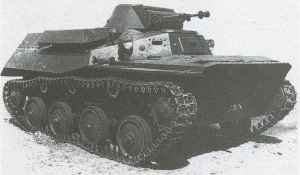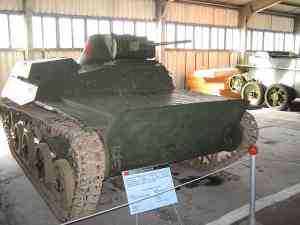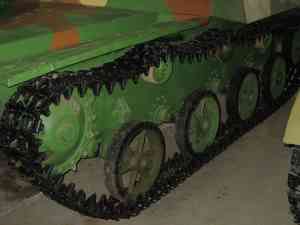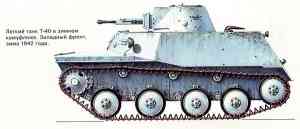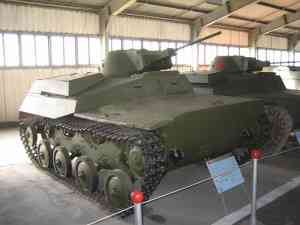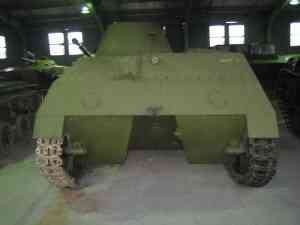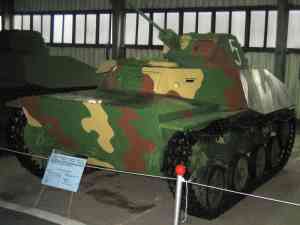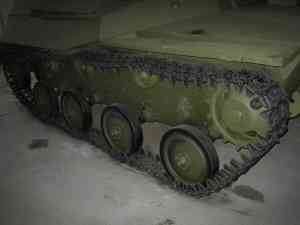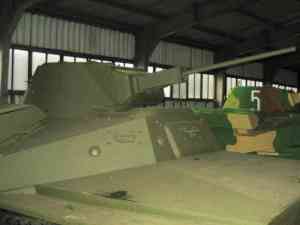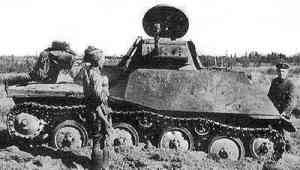In the Red Army's system of tank classification, light tanks (with weight up to 6 tons) were used by infantry and calvary units for reconnaissance, combat with enemy landing forces, and guard duty. Their very light protection, weak armament and small crew were compensated for by their mobility, small dimensions (especially length), very good maneuverability on rough terrain, and amphibious ability. In the 1930's, the Red Army had two models of light tanks: the T-37 and the T-38.
Soviet industry wasn't overburdened by manufacturing these tanks because their construction was very simple and cheap. Their production didn't demand scarce heavy armor plates or powerful engines. Therefore, such vehicles could be produced in less-specialized factories in large quantities. Since 1931, Moscow Factory #37 had developed several models of light tanks: tankette T-27 and T-27A; amphibious T-37A and T-38 (several versions); as well as the armored tractors "Pioneer" and "Komsomoletz".
At first, the T-38 was based on the Ford-AA engine. Later they were replaced with GAZ-AA and GAZ-M versions. The differential gear of the T-38 did not provide the vehicle with steady motion, so in 1936 it was replaced with more reliable and steady side-friction clutches with band brakes.
However, by 1938, the design of the T-38 had become obsolete, so the Red Army was in need of a new amphibious reconnaissance tank. The armor of this tank would have to protect from armor-piercing projectiles as well as from shell fragments. Sloped armor, increasing the tank's firepower, and the installation of a radio were some features considered for the new tank.
At the end of 1938, a special Research Department of factory #37 under Chief Engineer N.A.Astrov, undertook a new project, "010". The new hull and chassis were developed before the turret. The crew consisted of two men: a driver (located in the front of the hull) and a commander (in the turret). The design of the new vehicle allowed access to the engine from inside the vehicle once an armored partition was removed. The transmission was in the front of the vehicle as in the T-38. At the rear there were two fuel tanks of 100 liters each. The tank had a screw propeller and two rudders with armor protection to protect them from damage (from bullets, shell fragments and so).
Additional steps were made to improve the amphibious ability of the tank; the silhouette was improved, a special water deflector had been added, and all hatches were hermetically sealed. All of this allowed the T-40 to cross rivers with strong currents as well as through choppy seas (up to sea force 3). However, to be on the safe side, the crew was equipped with lifebelts.
In comparison with the T-38, the new vehicle was much better-armed with the large-calibre 12.7 mm DShK, and the 7.62 mm DT machine-guns. The machine-guns were paired and installed in one armored mount. The range of the DT was 1000 metres, and the range of the DShK was 4000 metres. The DShK had explosive, armor-piercing B-30, and incendiary armor-piercing B-32 bullets. The steel-cored B-30 bullet had a muzzle velocity of 850 m/s, and was able to penetrate 16 mm of vertical armor from a distance of 300 m. The tank was therefore able to combat low flying aircraft although such encounters were extremely rare. Both machine-guns were supplied by Kovrovskiy Factory #614. During Great Patriotic War, they were also produced in the Izhevskiy Industrial Plant #622.
The commander had three periscopic sights, and the driver had two. To navigate on water, in fog, and at night, the vehicle was equipped with a magnetic compass from the Moscow factory "Aviapribor." There was a 71-TK-3 radio (range 16 km) which was installed to the right of the commander's position.
The development of amphibious tank "010" was finished in the spring of 1939. In July 1939, Soviet industry built four experimental vehicles, and two more at a later date. They were equipped with imported Dodge engines and D-5's (76 h.p. or 85 h.p.), due to a lack of domestically-produced power plants. Some first series T-40's were equipped with these engines as well.
In July and August 1939, two "010's" (which had received the designation T-40) had been tested on both land and water. The results were sent to Moscow factory #37 with orders to fix all of the defects which were found. The length of the vehicle was increased by 120 mm, and it's width was increased by 50 mm. The height of the vehicle was lowered by 20 mm. A new engine, the GAZ-202 (GAZ-11), was mounted.
Upon GKO's #443ss decree of 19 December 1939, the new tank was accepted into service. This decree also ordered that; Moscow factory #37 was to produce three experimental T-40's by 1st March 1940, ordered the first production of 15 vehicles by 1 August 1940, and ordered the set up for mass production not later than 1st October 1940.
In the summer of 1940, G.K. Zhukov (Chief of the Soviet General Staff) and S.K. Tymoshenko (Soviet Minister of Defense) inspected factory #37. Zhukov was especially interested in the T-40 light tank, and the capabilities of factory #37 in general. He ordered the refit of some facilities to improve their output.
After an extensive refit of Moscow factory #37, and the setup of the newest technology and machine tools, the mass production of the T-40 was begun in October 1940. By the end of that year, the factory planned to produce 100 T-40 tanks, but had finished only 37 (plus six experimental tanks). In 1941, production had been increased, and by 22 June 1941, the factory had produced another 179 tanks.
The Red Army's need of tanks was so great that even weak tanks were needed badly. To increase the output of T-40's, the factory simplified construction of the vehicle. First of all, all the amphibious features and radio were removed. In July, 60 modernised tanks were built. According to archival documents, those tanks had the same name, but after the war they were renamed T-40S (where "S" means "sukhoputniy" or "overland"). The hull silhouette of the modernised tank was left unchanged. In spite of frequent requests, the armament of the T-40S wasn't changed.
Soviet soldiers investigating a T-40 that was knocked out at the beginning of the war. Sinyavino, Volkhov Front. September 1942.
Soviet soldiers investigating a T-40 that was knocked out at the beginning of the war. Sinyavino, Volkhov Front. September 1942.
However, in the Kubinka tank museum, there is a T-40S armed with a TNSh-20 automatic gun, but this is an experimental vehicle as all the operational T-40's and T-40S' were lost in battles. Similarly, a T-38 with a similar modification (i.e. with the TNSh-20) is now in Moscow's Central Museum of the Armed Forces.
In July 1941, the Narkomat of Weapons ("Narkomat" means Ministry) issued a decree to mount a 23 mm BT-23 (MP-6) automatic aircraft gun ("BT" denoting its main designers Baburin and Taubin). However, on 4 August 1941, firing tests of this gun gave negative results, so the gun was not installed on production vehicles.
From July 1941, the factory started producing the T-40S with flat rear armor plate (i.e. without a cavity for a screw propeller). Frontal and side armor of the hull was increased to 15 mm, and the frontal and side turret armor was increased to 20 mm. The vehicle had fully welded armor of homogenous steel. Unofficially, this vehicle received the "030" or T-30 designation. From September 1941, some production T-30's were armed with the 20 mm ShVAK automatic tank gun (with 750 rounds of ammunition), which was in the last stage of development.
In total, 443 vehicles were produced in 1941 in three different versions. However, these variants were never accepted by the Red Army, the T-30 designation was abandoned, and all the vehicles were designated simply as T-40's.
In general, the T-40 was a successful tank. Interestingly, even after the end of World War II, its main parameters (protection, armament, amphibious ability) were still satisfactory for the task of a light reconnaissance vehicle as compared with other post-war vehicles such as the ASU-76 (1949) and ASU-57P (1954).
Combat Employment
In the battles in which the T40's were first used, Soviet commanders tried to use the T-40's as regular tanks (like the T-26, BT's and so on). T-40's were never used in their intended reconnaissance role but were used for other, unintended tasks. Most of them were lost in battle without distinguishing themselves. The T-40 was used the most during the Moscow battles (winter 1941-1942). However, some of them took part from the beginning of the Great Patriotic war. They were very successful in marshes where heavier tanks couldn't pass.
T-40 light tanks were used in tank brigades of mixed composition. For example, in the 8th Tank Brigade (commanded by Colonel P.A.Rotmistrov, and formed in August-September 1941), there were 61 tanks which included seven KV-1's, 22 T-34-76's and 32 T-40's.
By mid 1941, the T-40 almost disappeared from the battlefields. However, during later crossings of large rivers (like the Dnieper, Dnestr and others) these tanks provided invaluable service to the Red Army.
That's why the Red Army's entire complement of T-38's were concentrated for the crossing of the Svir' River. By 1946, T-40's were relegated to use as training vehicles.
|



